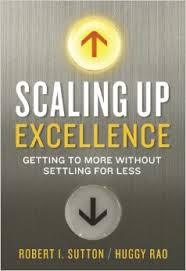Scattering smashed watermelons around Stanford's soccer field before the players arrived was just the first action that students in a class experiment took to sway athletes to wear bike helmets when cycling around campus. They also plastered posters around the field of apparently unconscious, helmetless students lying on the ground with smashed watermelons by their head. To scale support for your cause or organization, consider adapting these students' approach, described in Scaling Up Excellence, by popular Stanford professors Huggy Rao and Bob Sutton.
1. Get Popular Groups To Be Early Adopters
To convince more Stanford students to wear bike helmets the group decided to first convert college athletes, beginning with the soccer team.
2. Evoke High Arousal Emotions
Make your cause "hot" by evoking "strong feelings such as pride or righteous anger," advocate the authors, because "such feelings make people feel powerful and in control of the world around them, which in turn triggers assertive and confident action." Evoking pride, for example may a success of the anti-littering campaign Don't mess with Texas. Use the Compared to What? technique, in words and an image, to show the best case scenario they would want or worst case they'd want to avoid. A worst case, a damaged brain, was evoked by placing smashed melons next to unprotected heads of soccer players.
3. Stir Up A Collective Response When They Are Together
We are most likely to change when we experience seeing and doing something together. Emotions are contagious, especially when face-to-face. Scale support faster by "fueling a virtuous circle," suggest the authors, "creating experiences that generate 'communities of feeling.'"
4. Multiply Durable Ways They See Your Vivid Comparison
Soccer players found smaller versions of the posters they saw on the field when they returned to their bikes. The images were coated in plastic and attached to their handlebars.
5. Crystallize Your Campaign Around a Slogan They'll Want To Share
The students crafted a slogan for their campaign, "Love Your Lobes" with a tag line, "Love your life and serve your team by taking care of your brains." Appeal first to emotion, then to reason: they offered safety statistics that supported their campaign.
6. Create Calls for Actions They'll Want To Do
Galvanized by the images, the players were convinced "to sign a pledge to wear their helmets, post pictures of themselves and teammates wearing helmets on the Watermelon Offensive's Facebook page, and promise, 'If I catch another member of the team not wearing a helmet, I will throw a watermelon at them, with photographic evidence, if possible,'" wrote Rao and Sutton. The players were given watermelons that they were invited to throw at helmetless teammates and spread around the field. For the same goal, Stanford's Elisa Marie Geithner led Helmet Hookup, another campaign with a captivating call for action (free expresso) plus slogan: "Love coffee. Love your brain."
7. Amplify Accountability
The more actions we take on behalf of a belief, especially in quick succession and in the presence of peers and others, the more we deepen our belief and likelihood that we will continue to act on it. When designing your campaign - or rules of engagement in your organization - build in early and multiple ways that participants take visible actions that spur greater collective performance.
For more ideas about how to scale enduring success in your organization, read Bob Sutton and Huggy Rao's book, based on seven years of first-hand research, teaching and consulting. It passes my three-question test for a book worth reading:
1.Is it based on well-done research and/or actual experience?
2.Does it provide actionable insights?
3.Is it enjoyable to read?
Here are other new books I recommend for organizations to stay nimble and succeed in our increasingly disruptive world:
The Human Brand: Companies that really put their customers first, even when it's not in their short-term financial interest, boost genuine loyalty like a trusted friend. Many companies confuse consumers' repeated buying with loyalty, at their peril, and are deluded in believing that and reward programs also boost loyalty. Demonstrating warmth first then competence, as Amy Cuddy recommends, boosts trust in a company too.
The Solution Revolution: A growing number of innovative, often cross-sector collaborations offer our brightest promise to solve some of society's toughest problems, and are attracting some of our smartest and most motivated people.
Flex: In our increasingly complex yet connected world those who can "flex" behaviors to become the glue that holds diverse teams and new initiatives together will probably become our most valued leaders and partners.
The New Killer Apps: With the right approach large companies can innovate faster than start-ups.

